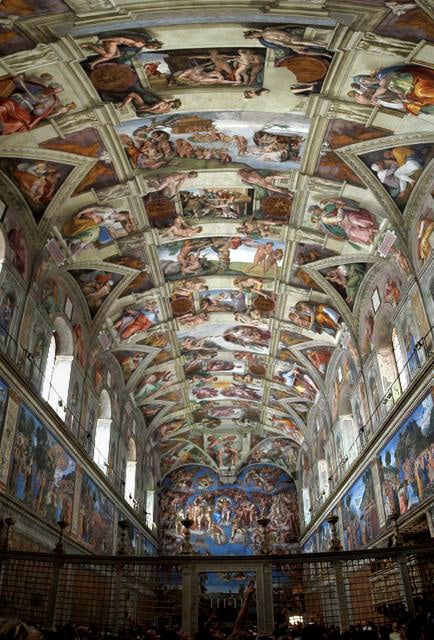Why are so many acorns represented in the frescoes of the Sistine Chapel?
The Sistine Chapel is one of the most famous cultural and artistic treasures of the Vatican City, included in the itinerary of the Vatican Museums in Rome. It was built between 1475…

Why are so many acorns represented in the frescoes of the Sistine Chapel?

…and around 1481, at the time of Pope Sixtus IV della Rovere, from whom it took its name. Why do so many acorns appear more or less hidden in the frescoes? Let’s find out together.
The Sistine Chapel is known throughout the world both for being the place where the conclave and other official ceremonies of the pope are held (in the past also some papal coronations), and for being decorated with the most famous works of art and celebrated of Western artistic civilization, among which stand out the famous frescoes by Michelangelo, which cover the vault (about 1508-1512) and the back wall (of the Last Judgment) above the altar (about 1535-1541).
The walls are decorated with a series of frescoes by some of the greatest Italian artists of the second half of the fifteenth century (Sandro Botticelli, Pietro Perugino, Pinturicchio, Domenico Ghirlandaio, Luca Signorelli, Piero di Cosimo, Cosimo Rosselli and others).

In most of the male nudes that decorate Michelangelo’s ceiling, there are acorns, a recurring motif among the artist’s frescoes to pay homage to the name of the Rovere (oak is synonymous with oak) to which the family of Sixtus IV belonged and of Julius II, the latter the Pope who asked Michelangelo to renovate the chapel.
In 1368 there is the first mention of a pre-existing papal chapel in the Vatican, which in the following year was decorated by Giottino and Giovanni da Milano. The intentions of restoring the most important Christian monuments of Rome, devastated by abandonment, neglect and civil strife during the Avignon captivity, was one of the most ambitious projects of the popes of the fifteenth century, starting with Martin V. Sixtus IV, former professor of theology in the major Italian universities and general of the Franciscans, he took up this commitment and already shortly after his election (August 1471). Construction began in 1477 with the supervision of the works by Giovannino de Dolci.

In the summer of 1481 it must have already been completed, as the development of the frescoed decoration of the walls is already documented. The appearance from the outside had to be grandiose, comparable only with buildings from the imperial age. The idea of having Michelangelo Buonarroti redo the decoration of the vault had to come to Pope Julius in April 1506. The immense work was completed between 1508 and 1512.

The young people of the vault hold festoons of oak leaves and acorns, or cornucopias from which acorns come out, or lean on sacks full of acorns, and those large acorns have an unmistakable phallic appearance; not only that, but they look exactly like the penis of the naked. So exactly that it is immediately excluded that it is a casual coincidence: Michelangelo painted acorns in the form of large phalluses, and penises identical, in a reduced proportion, to the acorns. A prank? Maybe, also because relations with Julius II were not always idyllic.

